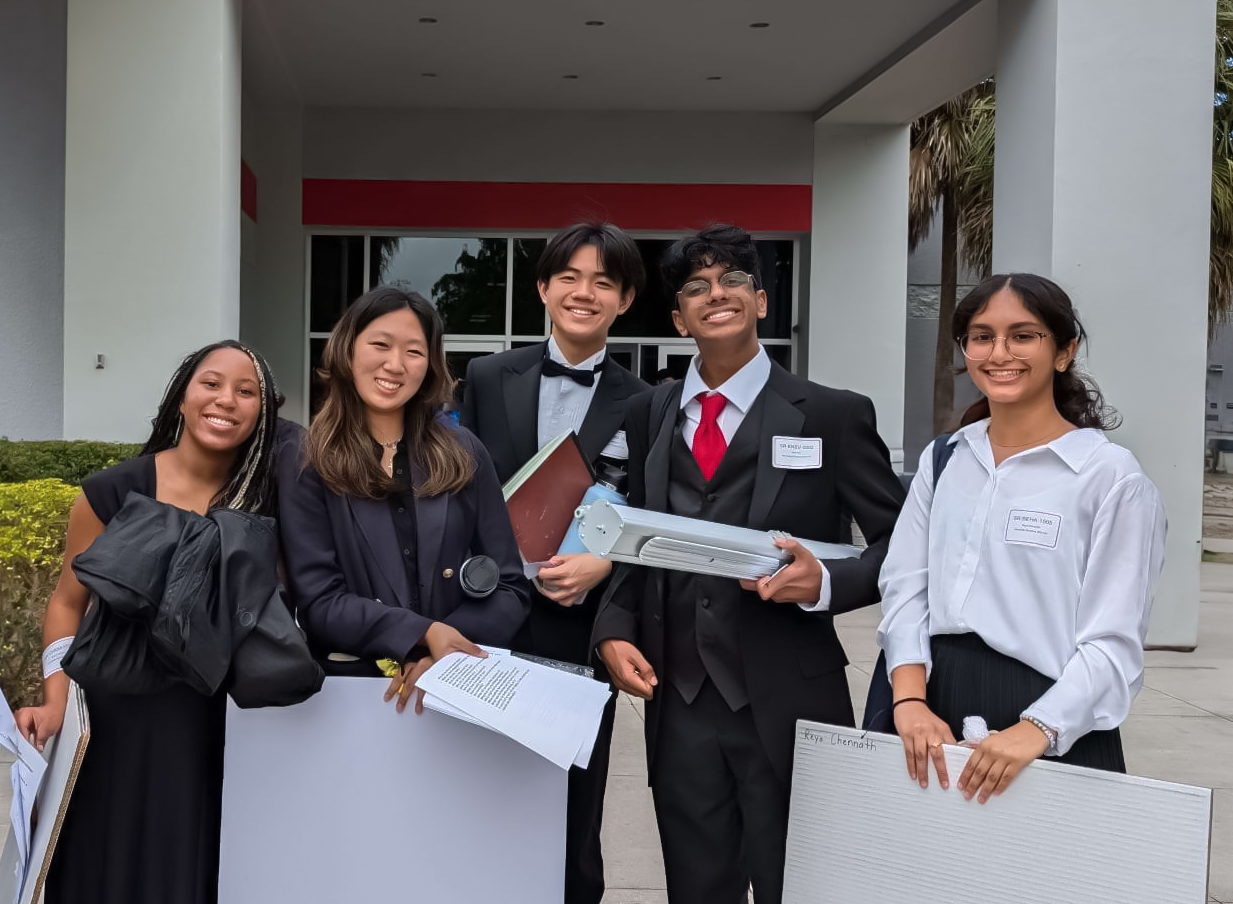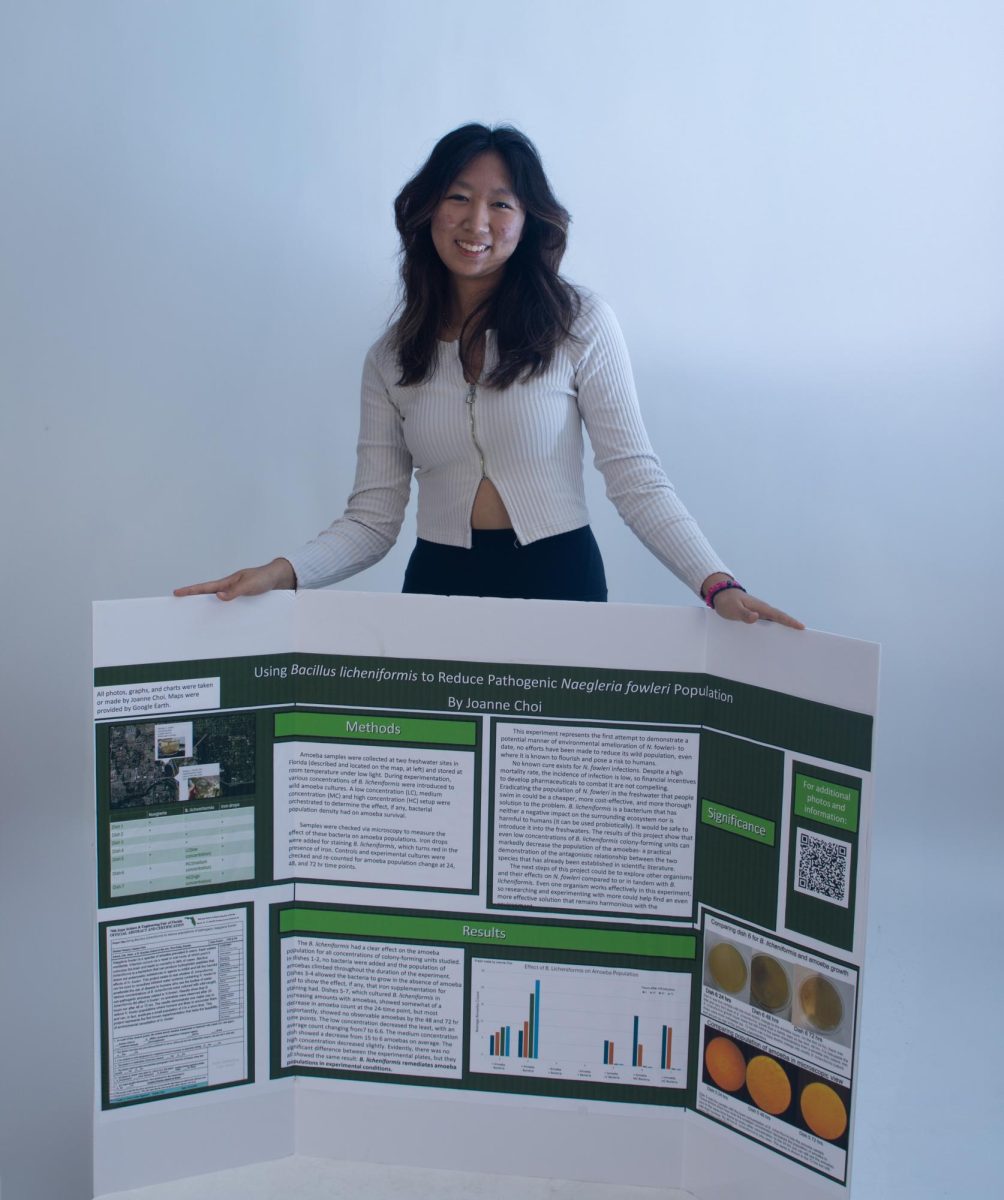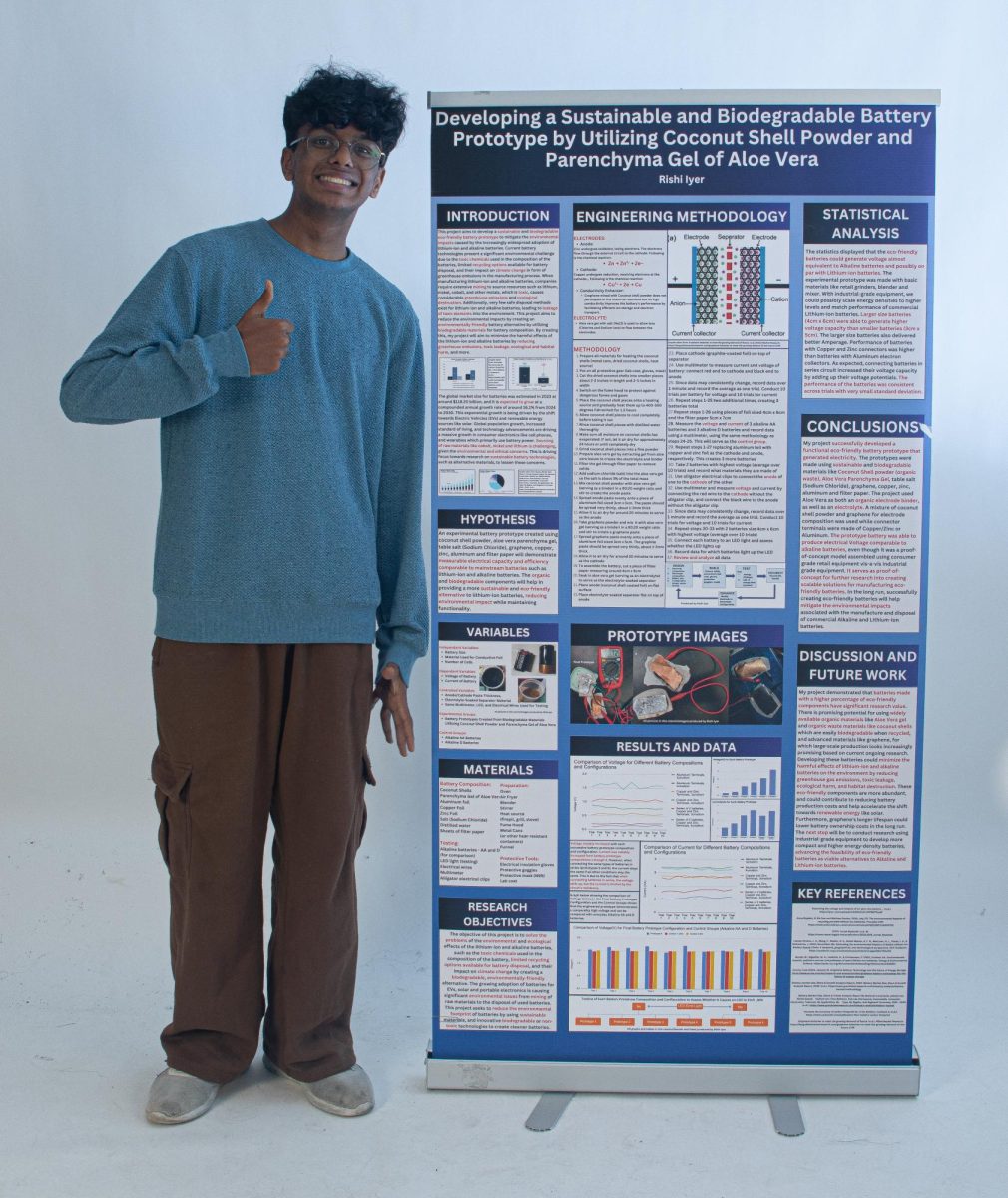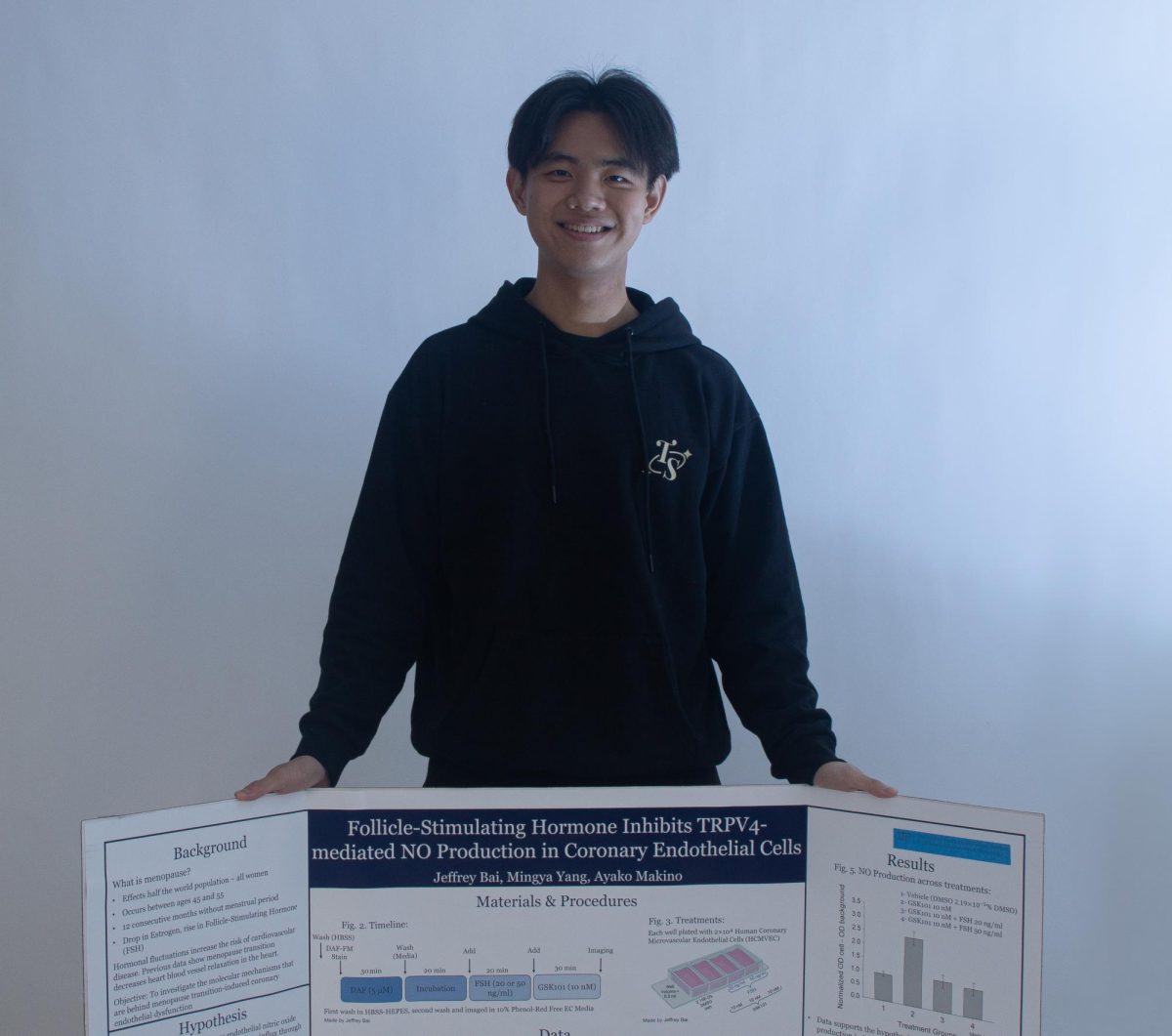It’s Not Rocket Science

Boards presenting months of experimentation tower over students who stand smiling in suits and dresses while judges stop to draw along yellow papers. Competing in the Palm Beach County Science and Engineering Fair comes with several hurdles: stacks of paperwork, months of research and testing (in some cases, inside of professional labs), and the pressure of competition. Ultimately, though, the fair brings some students closer to the sciences and appreciating all of the people supporting them along the way.
Over the 2024-2025 winter break, the science fair runners came to present their work at the fair. More than half of these students, including piano freshman Joanna Choi, piano sophomore Rishi Iyer, piano junior Nicholas Stan, and strings senior Jeffrey Bai, won podium spots. Both Stan and Bai have moved on to the national competition and will continue to compete at the state level.
Choi described her project to be on “brain-eating amoeba called Naegleria fowleri and how we can find a way to eradicate them in waters.” She did this by culturing, or sustainably growing, the amoeba and counting how certain time stamps compared to the populations of bacteria in different concentrations.
“I was looking into the microscope, and I found that bacteria killed the amoeba,” Choi said. “It was so fast. In less than 48 hours, all the amoebas were done.”
Throughout the project, Choi worked with her chemistry tutor, who is an accomplished scientist, and veterinarian father to learn how she would test her idea and culture the amoeba.
“I told her (my tutor) I was really interested in rare, hot topic diseases, and she told me to search the internet a bit more,” Choi said. “(I remembered that) I saw on Instagram about the brain-eating amoebas. My parents were also talking about it at the time.”
Although she had her idea set, Choi still had hardships ahead of her. One difficulty she faced was finding a way to use the resources she had to create a project so big.
“I wanted, at first, different organisms for eradication,” Choi said. “I ended up just taking one (species of amoeba) because of the limited number of organisms we could buy on the internet, and also for safety reasons.”
Choi faced another obstacle: culturing the amoeba.
“I wasn’t very knowledgeable on cultures and how to set up this project, but through the guidance of others, I was able to learn,” Choi said. “Even though they (Choi’s father and her chemistry tutor) didn’t directly help me with it, they taught and helped me on how to do it, and I was able to implement and do my research fairly.”
Choi also found that science dean Stephen Anand’s meetings helped with the progress of her project.
When speaking about her experience in these meetings, Choi said, “I talked to a lot of other people there and learned about their ideas, so it made us really connected.”
Science fair meetings ran for months before the competition and brought help in more ways than one.
“I have them test it (their project), and then look at how they test it,” Mr. Anand said. “Eventually, we put their research all together on the science fair board and write up a research paper for the science fair lab.”
Choi’s research focused on the extermination of disease-causing agents least expensively and most efficiently, rather than treatments and cures.
“When I read about the survivors of these brain-eating amoebas, (I learned that) they went through so much,” Choi said. “Even when they went through expensive treatments, it wasn’t even sure that you could actually treat them, and because scientists already act on the ‘It’s so expensive…it’s a very questionable type of treatment’ mentality, that really motivated me to just figure out a way where we can be sure and also cost-efficient.”
From last year’s Artificial Intelligence (AI) model identifying snakes in the Everglades to this year’s coconut and aloe vera battery, Rishi Iyer’s passion for environmental conservation has driven his engineering projects.
“Throughout the years, I’ve always wanted to do something in environmental science or environmental engineering, and this project really means a lot to me because I was able to solve a really big problem that I’ve been trying to find a solution for for a long time,” Iyer said. “It’s just a prototype right now, but I believe in the future I can continue working on this and develop (it) into something bigger and even more impactful.”
Iyer looked at the impact of lithium and cobalt batteries on the environment and wondered how he could make a better and more sustainable alternative.
According to the BBC, lithium extraction results in 15,000 kg of carbon dioxide emissions per ton through hard rock mining alone. The Federal Department Of Energy shows the further significance of this with there being 750 U.S Reserves, each with 1,000 metric tons, and 21,000 World Reserves, each with 1,000 metric tons as of 2021.
“(In) my own backyard, we have coconut gels and aloe vera, which we use really often,” Iyer said. “I was researching how batteries work and how I can use carbon sources with electrolytes (to make a battery). I found that aloe vera gel has really good electrolytes when it’s mixed with salt, and coconut shells are actually really good carbon sources (to transfer ions).”
Iyer worked with Mr. Anand and the science department to find where he could begin testing his designed prototypes and ended up using science teacher Marilynn Pedek Howard’s room. With the lab and the materials, Iyer tried to set his tests up but couldn’t quite crack a problem that came up on his own.
“Coconut shells are really, really sturdy and tough,” Iyer said. “I had a lot of trouble breaking them up, so (substitute teacher) Mr. (Sandy) Schuman recommended that I grind them in a blender, which was pretty helpful.”
After pulverizing the coconuts, he used a multimeter, a device that measures voltage, and alligator clips connected to an anode and cathode, the negative and positive ends of a battery.
“The voltage increases significantly by each prototype, and by the sixth one, it was about the same and even greater than the voltage of the double amp batteries,” Iyer said.
Although many people do observational scientific experiments, Iyer’s approach to engineering prototypes brings a different perspective.
“You have to design your own thing and express creativity through it,” Iyer said. “My hypothesis is I will be able to create a working prototype. My goal is to create a creative battery that’s comparable to lithium ion batteries and alkaline batteries.”
Though some portion of Iyer’s project was done alone, some components of the project could not have been executed without a lab, so Mr. Anand’s ability to provide resources was necessary to complete the project.
“Sometimes I get (the students) laboratories to work in,” Mr. Anand said. “Many times I get them laboratory supplies. Many times I continue to help them work on that research for many iterations.”
Other students, such as Bai and Choi, helped Iyer with the fair and became companions.
“Jeffrey (Bai) is always there to give me a little advice on my project, like on my board, because he’s a senior, so he has a lot of experience,” Iyer said. “Joanne (Choi) is always fun to work with because she shows me current projects, and we get to showcase our own work to each other.”
With the encouragement of his peers, Iyer hopes to bring it forward by advocating for the environment and encouraging others to perpetuate action towards healing it.
“I really hope to spark interest in other people and show them how they can also help in their own way to the environment,” Iyer said.
Jeffrey Bai’s project this year measured the effect of follicle-stimulating hormone in menopause with the production of nitrous oxide through TRPC1, which is the channel protein that allows the hormone to enter the cell.
“It’s good to see people researching around menopause because there’s so much funding that the government provides. (However) such a small portion of that is going to women, and of the funding going to women, it’s all about pregnancy, but such a small percentage goes to menopause,” Bai said. “And half the population goes through menopause. So it’s a huge topic, and I think it’s being understudied. So seeing a high school student come out and invest time and energy and effort into studying menopause (which is) a good first step.”
The opportunity to study such an intricate subcellular project came about as a result of Bai’s summer internship at the University of Florida’s Scripps Institute for Biomedical Innovation and Technology, a research center that offers rising juniors and seniors the opportunity to study fields such as biomedical research, drug discoveries, and molecular biology. By using this lab as a resource, Bai was able to bring his research to the next level.
“Last year, my project was all computer-based,” Bai said. “Once I saw everyone else’s projects (and all of the) different techniques and procedures that just couldn’t be possibly done at home, I realized how far I could get in my own projects if I could carry out these lab tests too.”
Scripps gave Bai mentorship that pushed his project, yet constraints still made themselves apparent, such as all of Bai’s other work during the first-semester of senior year.
“It was pretty tough because the first semester of senior year was a lot of work, so I took my entire Sunday basically every week (work on my project),” Bai said.
Spending time every week studying menopause changed Bai’s perspective on the condition and the symptoms associated with it.
“I would get irritated at my mom because sometimes she would be a little bit slow, but once you really look into what’s happening and all the side effects that come with menopause, it’s really not their fault, so we should give them an easier time,” Bai said.
The results of Bai’s research showed the importance of the specific levels of the follicle stimulating hormone in human blood, and how, in the case of menopause, the hormone would lose its effect if it was too high or too low of a level.
“There was a significant effect seen when the cells were treated with the human levels of the hormone, like the level of the hormone that’s representative of the human blood,” Bai said. “But when we increased the level of the hormone even more, there wasn’t any more effect. So it’s a critical point where, once you get to that human blood concentration of the hormone, higher concentrations don’t have those dependent effects.”
Bai’s results at the fair is an accomplishment, but the research he did to get there already made him a winner in Mr. Anand’s eyes
“It’s not about anybody else telling you (that) you won. It’s about you conducting the scientific process,” Mr. Anand said.
This sentiment is evident in Bai’s reflection on his time doing the Science and Engineering Fair in which he said he did what was important to him, namely research in the field of the cardiovascular system and metabolism.
“Once (I did) the research that I was so proud of, I wanted to show it off to the world and get expert opinions and critiques on it,” Bai said. “I think (the) science fair is great for students to bring their passion, their projects, (and) their research to the outside world.”
Nitroplasts, which fix nitrogen, are rare new organelles found in one sensitive species of algae, Braarudosphaera bigelowii. In a matter of months, Nicholas Stan endeavored to find which environment this widespread yet very sensitive species of algae is most comfortable in, taking a step forward towards answering questions about cultivation that algae scientists have been conflicted with.
“I was just reading through a few articles, and I noticed that a consistency among the articles was that the recent ones mentioned an issue that they had was (not being able to) culture (the algae) at all,” Stan said. “The reason I decided to study how it does in these sorts of environments and how it reacts to stress is because I wanted to start going in the right direction for culturing it because (it’s) the first step to finding out in what condition it is the least stressed and the most comfortable in.”
Stan’s project, although only using materials from Mr. Anand’s classroom, tested temperature and pH in different environments with hydrochloric acid, baking soda, a heater, and a cooler, which gave him the chance to do what he could not have done before. During COVID-19, Stan missed the opportunity to use a microscope, but this year’s competition gave him the chance to use one for the first time, which was what he claimed to be the most fascinating part of the process.
“Seventh grade was when you got to do all the exciting stuff, like dissections, microscopes, looking at plants under microscopes and cells and everything like that, (but) I got to do none of that because of COVID,” Stan said. “I had been completely in the dark on stuff like that. That was honestly the most fun part because I got to use a microscope for the first time, which was an eye-opening experience for me because I knew that (this specific topic) was what I wanted to do. It (using the microscope) really solidified it (my topic).”
Being able to learn and cultivate his own research led Stan not only to test what he found interesting online, but also to better grasp his passion for science.
“You’ve heard me many times encourage you guys to test things that are important to you, things that you guys are interested in,” Mr. Anand said.
Mr. Anand pushed Stan to pursue the project and gave him the space to test it when he felt discouraged from participating in this year’s fair.
“If (Mr. Anand) had not pushed me to do all of the paperwork the weekend before it was due, I would not have done it because I thought I was too late,” Stan said. “I walked up into this class, and I was joking, saying, ‘Oh, you think I still have time?’ And he’s like, ‘Yeah, I mean, if you cram it all out this weekend,’ so I did.”
The challenge of the time Stan had to dedicate to the Science and Engineering Fair persisted past paperwork, going on to his research. After collecting the algae off the shore of Palm Beach, using a five-micron filter to collect samples, he began his investigation.
“If you ask people from a biology class, I was in here day in, day out at lunch,” Stan said. “(I spent) every day sitting at the microscope looking at different samples, taking photos all lunch every day for a month. It was pretty hard because I had to keep up the consistency and so I had to give up various club meetings and such.”
Not only was Stan put to the test in terms of time, but the results started to seem waning as well until he sat down for closer inspection at last.
“Originally, I thought that my conclusions were completely inconclusive because none of them lived longer in any conditions that I changed,” Stan said. “One thing I had realized was that (the one) that lived essentially as long as the control was the one that was in a more basic medium (pH). On top of that, the only thing that was different about the basic medium is that even though it lived the same amount of time, it lived with less visible stress factors, like it didn’t change shape as much. It wouldn’t harden, constrict, (or) expand, and died more so from its natural lifespan rather than because it was stressed out by the environment.”
While at first Stan wanted to pursue a project in biomedicine, he was limited by the rules against testing on humans. This did not stop him from studying what he really wanted to do, though the project was not directly on biomedicine.
“I wanted to do something that would allow me to explore the lifespan of a cell and how it’s affected by its environment, what causes its different energy change because of the environments,” Stan said. “(I wanted to find) a new discovery. I just saw it, and I thought, ‘This is new, might as well try.’”
Your donation will support the student journalists of Dreyfoos School of the Arts. Your contribution will allow us to purchase equipment and cover our annual website hosting costs.






